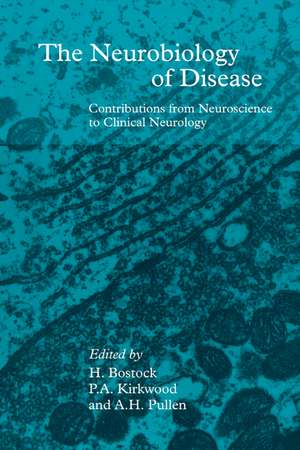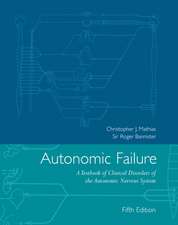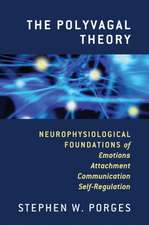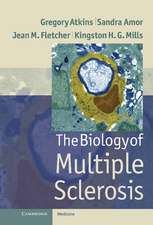The Neurobiology of Disease: Contributions from Neuroscience to Clinical Neurology
Editat de Hugh Bostock, P. A. Kirkwood, A. H. Pullenen Limba Engleză Paperback – 29 iun 2011
| Toate formatele și edițiile | Preț | Express |
|---|---|---|
| Paperback (1) | 657.87 lei 43-57 zile | |
| Cambridge University Press – 29 iun 2011 | 657.87 lei 43-57 zile | |
| Hardback (1) | 1273.29 lei 43-57 zile | |
| Cambridge University Press – 17 apr 1996 | 1273.29 lei 43-57 zile |
Preț: 657.87 lei
Preț vechi: 692.50 lei
-5% Nou
Puncte Express: 987
Preț estimativ în valută:
125.92€ • 136.83$ • 105.84£
125.92€ • 136.83$ • 105.84£
Carte tipărită la comandă
Livrare economică 21 aprilie-05 mai
Preluare comenzi: 021 569.72.76
Specificații
ISBN-13: 9780521342384
ISBN-10: 0521342384
Pagini: 464
Dimensiuni: 152 x 229 x 26 mm
Greutate: 0.68 kg
Editura: Cambridge University Press
Colecția Cambridge University Press
Locul publicării:Cambridge, United Kingdom
ISBN-10: 0521342384
Pagini: 464
Dimensiuni: 152 x 229 x 26 mm
Greutate: 0.68 kg
Editura: Cambridge University Press
Colecția Cambridge University Press
Locul publicării:Cambridge, United Kingdom
Cuprins
Part I. Physiology and Pathophysiology of Nerve Fibres: 1. Ion channels in normal and pathophysiological mammalian peripheral myelinated nerve J. M. Ritchie; 2. Molecular anatomy of the node of Ranvier: newer concepts S. G. Waxman; 3. Delayed rectifier type K+ currents in rabbit and rat axoms and Schwann cells M. Baker; 4. Axonal signals for potassium channel expression in Schwann cells T. Konishi; 5. Ion channels in human axons G. Reid; 6. An in vitro model of diabetic neuropathy: electrophysiological studies P. Grafe; 7. Autoimmunity at the neuromuscular junction J. Newsom-Davis; 8. The immunopathology and pathophysiology of experimental autoimmune encephalomyelitis M. P. Pender; 9. The pathophysiology of human demyelinating neuropathies T. E. Feasby; 10. Conduction properties of central demyelinated axons: the generation of symptoms in demyelinating disease K. J. Smith; 11. The mechanisms of relapse and remission in multiple sclerosis W. I. McDonald; 12. Glial transplantation in the treatment of myelin loss or deficiency J. Rosenbluth; Part II. Pain: 13. Human nociceptors in health and disease J. Ochoa; 14. The sensory consequences of inflammation A. Iggo; 15. Non-voluntary motor unit activity and myofascial pain syndromes R. H. Westgaard; 16. Is there a mechanism for the spinal cord to remember pain? W. D. Willis Jnr; 17. The neurophysiological basis of pain relief by acupuncture E. Shen; Part III. Control of Central Nervous System Output: 18. Synaptic transduction in neocortical neurones W. E. Crill; 19. Cortical circuits, synchronization and seizures J. G. R. Jefferys; 20. Physiologically induced changes of brain temperature and their effect on extracellular field potentials P. Anderson, E. Moser, and V. Jensen; 21. Fusimotor patterns of respiratory muscles A. Taylor, and R. Durbarba; 22. Cerebral accompaniments and functional significance of the long-latency stretch reflexes in human forearm muscles M. Aminoff, and S. Goodin; 23. The cerebellum and proprioceptive control of movement A. Prochazka et al; 24. Roles of the lateral nodulus and uvula of the cerebellum in cardiovascular control N. Nishimaru; 25. Central actions of curare and gallamine: implications for reticular reflex myoclonus W. Burke; 26. The pathophysiology of upper motoneurone disorders H-J. Freund; 27. Modulation of hypoglossal motoneurones by thyrotropin releasing hormone and serotonin A. J. Berger et al; 28. Serotonin and central respiratory disorders in the newborn G. Hilaire, D. Morin et al; 29. Are medullary respiratory neurones multipurpose neurones? L. Grélot et al; 30. Reflex control of expiratory motor output in dogs J. R. Romaniuk et al.; 31. Abnormal thoracoabdominal movements in patients with chronic lung disease M. Goldman; 32. Respiratory rhythm and apnoeas in the newborn B. Duron; 33. Cardiorespiratory interactions during apnoea C. P. Seers; 34. Impairment of respiratory control in neurological disease R. S. Howard; 35. The respiratory muscles in neurological disease G. H. Mills and M. Green; Part IV. Development, Survival, Regeneration and Death: 36. Axonal growth and plasticity in the adult nervous system J. Diamond, and A. Gloster; 37. Target dependence of motoneurones I. P. Johnson; 38. Rescue of neurones cross-regenerated into foreign targets J. B. Munson, and H. Nishimura; 39. Development and repair of neonatal mammalian spinal cord in culture J. G. Nicholls, and Z. Varga; 40. Selective neuronal vulnerability in motor neurone diseases with reference to sparing of Onuf's nucleus A. H. Pullen; 41. Excitotoxicity in motor neurone diseases C. Krieger.
Recenzii
"...a valuable read as it projects an immediate overview and understanding of key membrane and molecular events involved in axonal conductions and mechanisms of neural control and neural viability in health and disease." Roger N. Rosenberg, Archives of Neurology
"...this is a well-written, adequately illustrated, and generally interesting textbook that will be found a useful resource for neuroscientists of all different specialties." Martin Bettag, Neurosurgery Review
"...this is a well-written, adequately illustrated, and generally interesting textbook that will be found a useful resource for neuroscientists of all different specialties." Martin Bettag, Neurosurgery Review
Descriere
This volume demonstrates the value of interactions between neurology and the basic sciences that underpin it.







